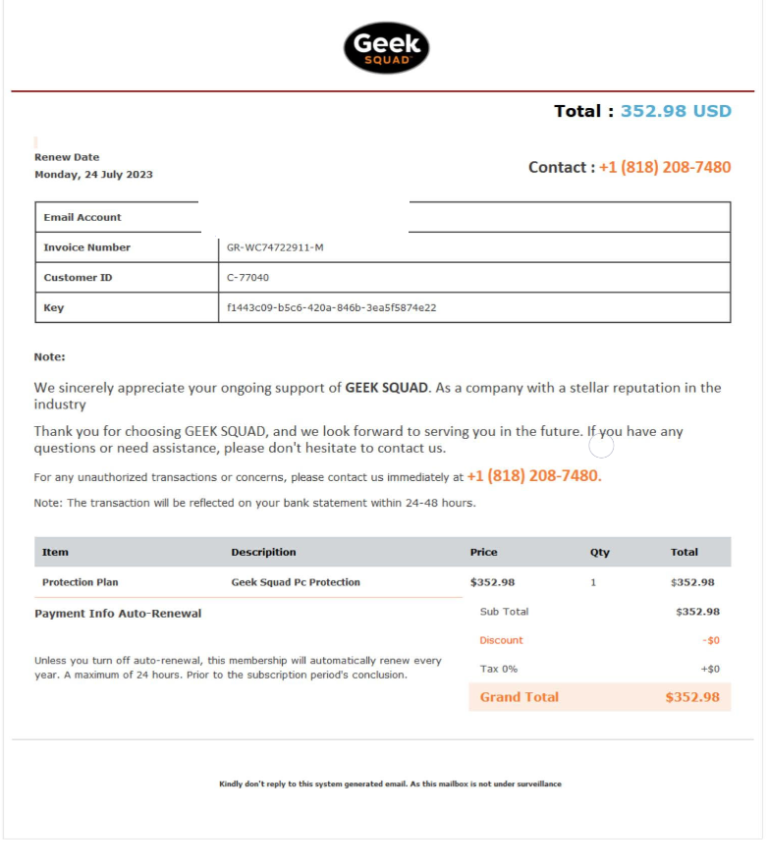Introduction:
Hey Scam Warriors! In our previous blog post, we learned about three kinds of Geek Squad email scams which were AMC scams, phishing Email scams, and identity theft scams. In this particular blog post, we are diving deep into Geek Squad phishing email scam. It involves scammers replicating Geek Squad’s emails and sending them in bulk to people with the intention of stealing their information, connecting with their devices remotely, and charging money for fake services.
What is a Geek Squad Phishing Email Scam?
A Geek Squad phishing email scam is a type of online fraud where cybercriminals send fake emails purporting to be from Geek Squad, the tech support arm of Best Buy. The objective is to trick recipients into providing personal information, financial details, or access to their computers. These scams often appear legitimate, making it challenging for unsuspecting users to discern their fraudulent nature.

How does a Geek Squad phishing email work?
In these scams, the victim first receives an email supposedly from Geek Squad. These emails often look remarkably legitimate, incorporating official logos, branding, and contact information to deceive unsuspecting users. The scam typically involves an urgent message, such as a notification about a pending subscription renewal, a claim of a refund due to a service cancellation, or an alert about a detected issue or security threat on the recipient’s device. The email instructs the recipient to take immediate action, which might include clicking a link, downloading an attachment, or calling a provided phone number.
The links in these emails often direct recipients to fake websites designed to capture personal information or login credentials, mimicking the official Geek Squad site but controlled by scammers. Attachments may contain malware or spyware, which, when opened, can steal information or give the scammer control over the recipient’s computer. If a phone number is provided, calling it connects the recipient to a scammer posing as a Geek Squad representative, who then asks for personal information, credit card details, or remote access to the computer. In all the scenarios, the scammer’s only intention is to steal your online banking credentials and drain money from your bank account, and to do the same they may ask you to buy gift cards or make payment with cryptocurrencies.
6 Ways To Prevent Geek Squad Phishing Email Scams
1. Verify the Source: One of the most critical steps in protecting yourself from phishing scams is to verify the source of any email claiming to be from Geek Squad. Start by checking the sender’s email address meticulously. Scammers often use email addresses that look similar to official ones but may contain minor discrepancies, such as slight misspellings or unusual domain names that differ subtly from legitimate Geek Squad or Best Buy addresses. For example, instead of an email from “support@geeksquad.com,” you might see something like “support@geeksquadsupport.com.” These minor differences are easy to overlook, so it’s essential to examine the email address carefully.
2. Do Not Click Links: Phishing emails typically include links designed to lure you into providing personal information or downloading malware. To protect yourself, avoid clicking on any links in unsolicited emails. These links can direct you to fake websites that mimic the appearance of official Geek Squad sites but are actually controlled by scammers. Instead of clicking on the links provided in the email, go directly to the Geek Squad or Best Buy website by typing the URL into your browser’s address bar. This ensures you are accessing a legitimate site and not a fraudulent one.
3. Do Not Open Attachments: Attachments in phishing emails can contain malware or spyware that, when opened, can infect your computer and compromise your personal information. As a rule, never open attachments from unknown or unexpected sources. If an email claims to be from Geek Squad and includes an attachment, be especially cautious. Legitimate communications from Geek Squad typically do not include unsolicited attachments.
4. Use Security Software: Ensuring your computer is equipped with up-to-date antivirus and anti-malware software is a vital defense against phishing scams. This software can detect and block malicious emails and attachments before they can harm your system. Regularly updating your security software is essential to protect against the latest threats and vulnerabilities.
5. Report the Email: If you receive a suspicious email claiming to be from Geek Squad, take action by reporting it. Forward the phishing email to Geek Squad or Best Buy’s official support channels for verification. Additionally, you can report the email to your email provider, which helps them improve their spam and phishing filters. Reporting the scam to the Federal Trade Commission (FTC) is also important as it helps authorities track and combat phishing activities.
6. Stay Informed: Educating yourself about common phishing tactics and recognizing the signs of scam emails is crucial in protecting yourself. Phishing emails often create a sense of urgency or fear to prompt immediate action, use generic greetings like “Dear Customer,” and may contain spelling or grammatical errors. Staying informed about these common tactics will help you identify and avoid phishing scams more effectively. This book can help.
By staying vigilant and following these guidelines, you can significantly reduce your risk of falling victim to Geek Squad phishing email scams. Awareness and proactive measures are your best defenses against these fraudulent activities.




